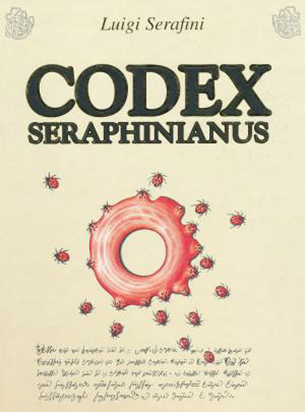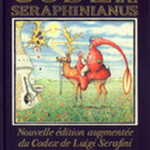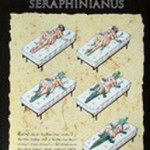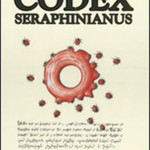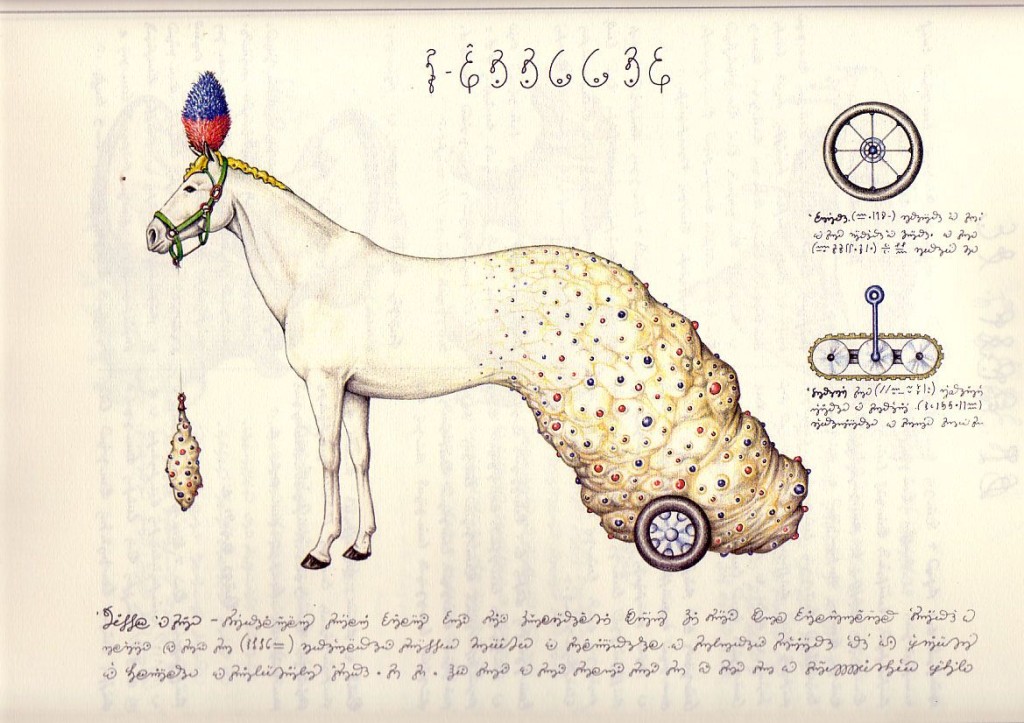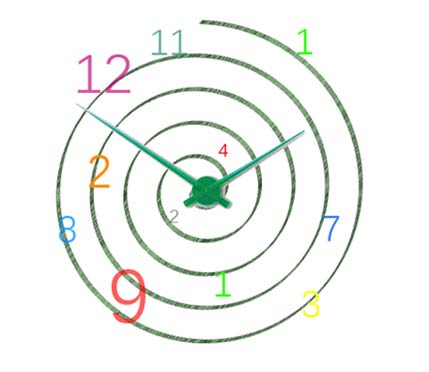Some people think it’s one of the weirdest books ever published. An art book unlike any other art book. A unique and disturbing surreal parody. Grotesque and beautiful. It’s very hard to describe. Codex Seraphinianus by Italian artist Luigi Serafini is a window on a bizarre fantasy world complete with its own unique (unreadable) alphabet and numerous illustrations that borrow from the modern age but veer into the extremely unusual. It was first published in two volumes by Franco Maria Ricci in 1981. The pictures in this AbeBooks article are from the 1983 American edition published by Abbeville – 370 pages of the Twilight Zone. There is also a 1993 single volume edition and a recent 2006 edition published byRizzoli.
Created in the late 1970s, the book’s blurb on the cover flap talks about Codex Seraphinianus being a book for the “age of information” where coding and de-coding messages is increasingly important in genetics, computer science and literary criticism. “The Codex presents the creative vision of this time…” goes on the blurb. If Serafini was so influenced by “information” in the 1970s to create this maverick art book, then what must he make of today’s information age? Codex Seraphinianus Covers featuring Facebook, Twitter, blogs and Google? Countless websites and blogs can be found pondering the meaning of Codex Seraphinianus or simply admiring a truly original piece of art/fantasy/imagination – call it what you will.The cover alone is worth studying.
The 1991 Abbeville edition features a couple having sex and being transformed into a crocodile. Shakespeare described sex as the “beast with two backs” but Serafini is operating on a different level to the Bard. The 1993 edition uses a different image for its cover – a man in very unpractical headwear appears to be riding a llama, which has an impressive set of antlers.They are both staring into a mirror outside a stone building that appears to be offering some sort of brightly colored food. Both covers are strange but the crocodile sex image is more disturbing.Essentially an encyclopedia about an alien world that clearly reflects our own, each chapter appears to deal with key facets of this surreal place, including flora, fauna, science, machines, games and architecture. It’s difficult to be exact because no-one has ever understood the contents page.
Elements of today’s world are visible but they are nearly always given some surreal twist – floating flowers, a peeled banana containing pills, a strange car covered in flies, clothing that would seem strange even in the 1970s, a man wearing roller-skates – with a fountain pen’s nib instead of a hand – stabbed through the chest with a pen, and lots of biped creatures with human legs attached to all manner of crazy things.
Artists have studied the book’s illustrations, philosophers have pondered the book’s meaning, codebreakers have tried (unsuccessfully) to decipher the text (although the numbers are now understood apparently), science fiction and fantasy fans have embraced it, and academics have tried to classify the book. Collectors just like to own it – an invaluable tool for making house-guests slightly uneasy.
Richard Davieshttp://www.abebooks.com/books/RareBooks/serafini-fantasy-art-weird/Codex-Seraphinianus.shtml
The Codex Seraphinianus,[1] originally published in 1981, is an illustrated encyclopedia of an imaginary world, created by Italian artist, architect and industrial designer Luigi Serafini between 1976 and 1978.[2] It has approximately 360 pages (depending on edition) and is written in an imaginary language.[3] Originally published in Italy, it has been released in several countries.[3] DescriptionThe Codex is an encyclopedia in manuscript with copious hand-drawn, colored-pencil illustrations of bizarre and fantastical flora, fauna, anatomies, fashions, and foods.[4] It has been compared to the still undeciphered Voynich manuscript,[5] the story "Tlön, Uqbar, Orbis Tertius" by Jorge Luis Borges,[6] and the artwork of M. C. Escher[7] and Hieronymus Bosch.[3][4] The illustrations are often surreal[4][7][8] parodies of things in the real world, such as a bleeding fruit, a plant that grows into roughly the shape of a chair and is subsequently made into one, and a copulating couple who metamorphose into an alligator. Others depict odd, apparently senseless machines, often with delicate appearances and bound by tiny filaments. Some illustrations are recognizable as maps or human faces, while others (especially in the "physics" chapter) are mostly or totally abstract.[3] Nearly all of the illustrations are brightly coloured and highly detailed. Writing systemThe false writing system appears modeled on Western writing systems, with left-to-right writing in rows and an alphabet with uppercase and lowercase letters, some of which double as numerals. Some letters appear only at the beginning or end of words, similar to Semitic writing systems. The curvilinear letters are rope- or thread-like, with loops and even knots,[5] and are somewhat reminiscent of Sinhala script.[9] In a talk at the Oxford University Society of Bibliophiles on 11 May 2009, Serafini stated that there is no meaning behind the Codex's script, which is asemic; that his experience in writing it was similar to automatic writing; and that what he wanted his alphabet to convey was the sensation children feel with books they cannot yet understand, although they see that the writing makes sense for adults.[10] However, the book's page-numbering system was decoded by Allan C. Wechsler[11] and Bulgarian linguist Ivan Derzhanski,[12] as being a variation of base 21.[5] ContentsThe book is in eleven chapters, in two sections. The first section appears to describe the natural world of flora, fauna and physics. The second deals with various aspects of human life, including garments, history, cuisine and architecture. Each chapter seems to address a general encyclopedic topic, as follows:
After the last chapter is a table of contents or index, followed by an apparent afterword whose writing is more casually rendered.[3] Two plates in the sixth chapter contain lines of French text, a quote from Marcel Proust's "À la recherche du temps perdu: Albertine disparue" (In Search of Lost Time: Albertine Gone). The words scattered on the floor of the illustration are from the same book. Editions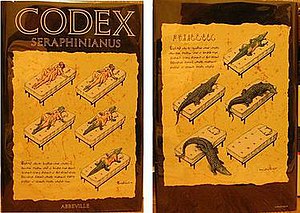 The original edition was issued in two volumes:
Two years later, a single-volume edition was issued in the United States, in Germany and in the Netherlands:
The 1980s editions were out of print for several years before Franco Maria Ricci published an augmented, single-volume edition in 1993:
In 2006, Rizzoli published an expanded, but less expensive, edition in Italy. It features additional illustrations and a preface by the author:
In 2013, Rizzoli published a second revised edition, as well as limited, signed, and numbered "deluxe" edition. They printed 300 copies in Italian and 300 in English:
In 2016, a 2017 Codex Seraphinianus wall calendar was published by Universe Publishing.
Rizzoli published a 40th anniversary edition of Codex Seraphinianus with some additional material in 2021.
ReceptionBaird Searles, in Asimov's Science Fiction (April 1984), says "the book lies in the uneasy boundary between surrealism and fantasy, given an odd literary status by its masquerade as a book of fact".[7] Douglas Hofstadter, in Metamagical Themas, finds many of the illustrations "grotesque and disturbing" and others "extremely beautiful and visionary". He says the book "seems [to some people] to glorify entropy, chaos, and incomprehensibility".[13] American journalist Jim Dwyer finds that the work is an early critique of the Information Age.[8] See also
References
External links
|
||||||||||||||||||||
The following are a list of links for those interested in learning more about the Codex Seraphinianus, and reading what others are saying about it.
An article on the glyphs by Tomi Melka and Jeffrey C. Stanley in Writing Systems Research (purchase from Taylor & Francis)
An article by Justin Taylor: http://www.believermag.com/issues/200705/?read=article_taylor
An article by Peter Schwenger: http://faculty.msvu.ca/pschwenger/codex.htm
An attempt at translation, although a bit of a long stretch by James M. Duyer: http://www.event12.com/seraphinianus/codex/index.html
A tiny review at Beachcombing Blog http://www.strangehistory.net/2011/01/21/review-the-codex-seraphinianus/
An article by John Coulthart http://www.johncoulthart.com/feuilleton/writings/another-green-world-the-codex-seraphinianus/
My article (tongue in cheek): http://scriptjr.nl/issues/2.1/on-the-codex-seraphinianus-kane-x-faucher.php
Ivan A. Derzhanski’s number crack http://www.math.bas.bg/~iad/serafin.html
Nick Pelling reviews the 2013 reissue
